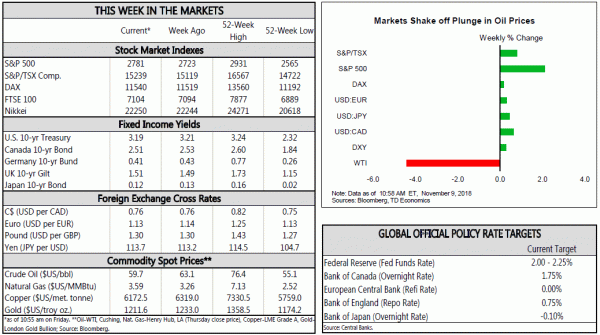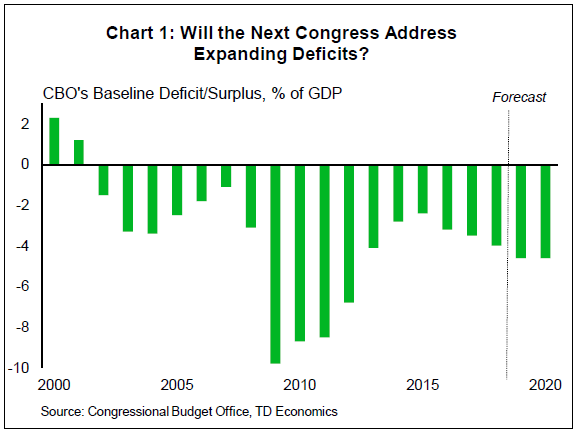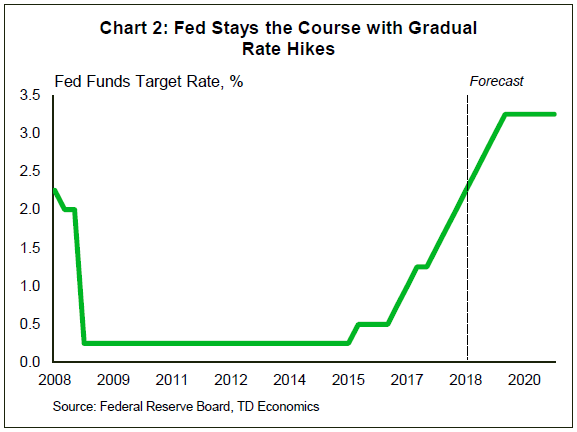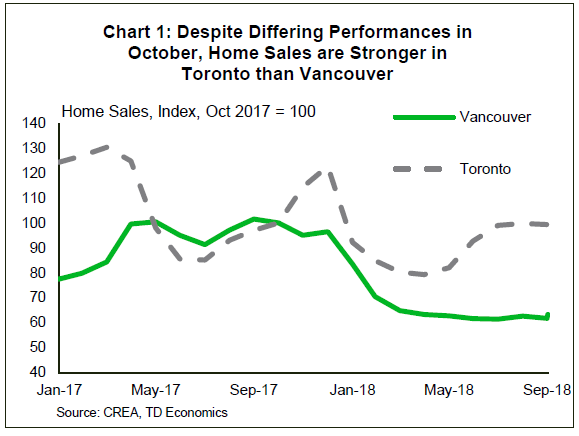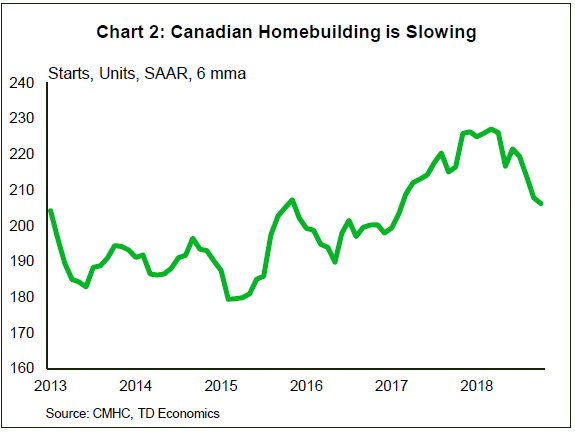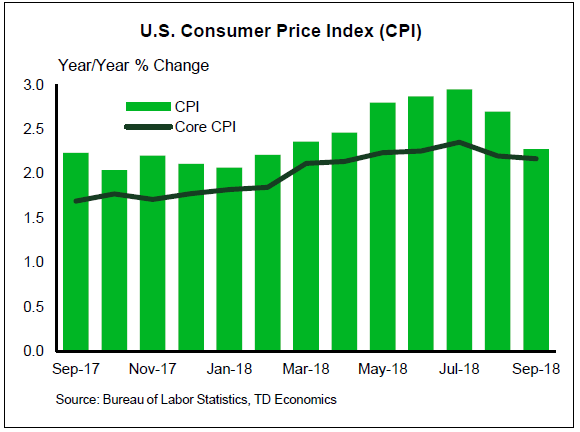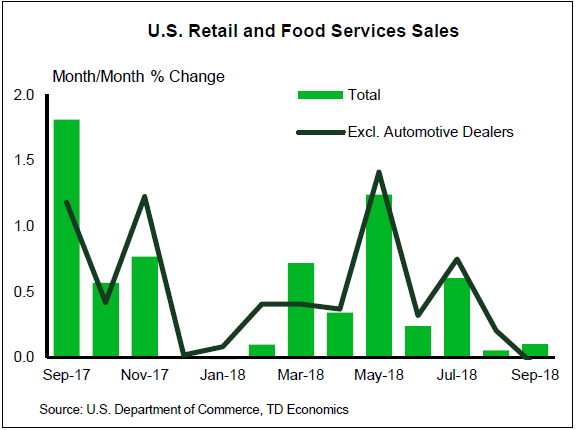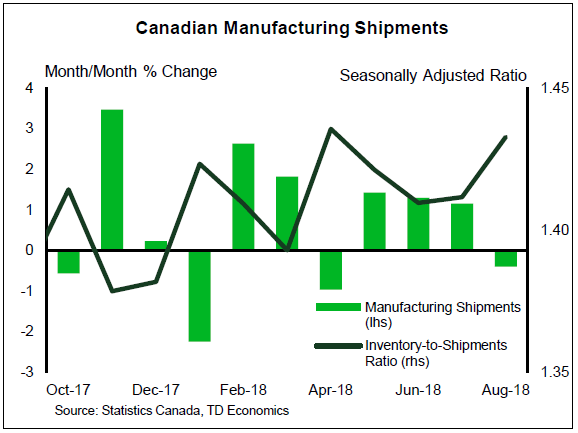U.S. Highlights
- Between the midterm elections and a Fed rate decision there was plenty of news this week. But after the dust settled there was very little new information.
- In the midterm elections, Democrats gained a majority in the House of Representatives, and Republicans tightened their grip on the Senate. A divided Congress through 2020 will temper parts of Trump’s agenda, and could make some upcoming fiscal tests more challenging.
- As expected, the Federal Reserve left rates unchanged, with a largely unchanged statement. Recent economic data suggest the next hike is coming in December.
Canadian Highlights
- Housing dominated the economic calendar this week. Homebuilding continued to cool on a trend basis in October. A third quarter drop in residential permits suggests that further easing is in store.
- Against a backdrop of rising rates, Toronto home sales dropped in October. They appear to have fared better in Vancouver during the month, though activity in the GVA remains depressed amid severely strained affordability.
- Historical revisions to Canadian GDP growth released this week likely did little to alter thinking at the BoC.
U.S. – Plenty of News, But Not Much New
Between the midterm elections and a Fed rate decision there was plenty of news this week. But after the dust settled there was very little new information. As was widely expected, the Democrats gained a majority in the House of Representatives, and Republicans tightened their grip on the Senate. A divided Congress will temper Trump’s agenda, but much depends on the Democrats’ strategy for working with the GOP. Even less surprising was the Federal Reserve’s decision to hold the funds rate steady, after hiking in September. Equity markets seemed pleased with these largely as expected results.
Congress is now gridlocked through 2020, which raises risks on a variety of fronts. A few tests loom on the near-term horizon. Currently 25% of discretionary spending for the 2019 fiscal year is under a temporary funding agreement until December 7th. The current Congress will likely kick the can into early 2019, which sets up a potential funding battle and the risk of a partial government shutdown in the New Year. Government shutdowns are a risk with a divided government, but typically these do not have a meaningful impact on economic activity (as they have not proved long lasting).
The second fiscal test is the debt ceiling, which is set to be re-instated in March 2019. It must be raised or suspended again to prevent a debt crisis or huge fiscal contraction. We expect Congress will come to an agreement to avert a crisis, but there could be some fireworks in the process. Finally, Congress must enact legislation to avoid automatic spending cuts of $100 billion in FY2020. Our base case is that this is avoided, but if not, it could trim 0.5 percentage points from GDP growth in that year. In the wake of tax cuts and spending increases the federal deficit has grown, and is expected to swell further (Chart 1). This could become a political issue that makes a budget compromise more difficult.
As President, Trump has the authority to push ahead with his trade agenda. He may even get some support from the Democratic House for a harder stance on China. As such, the increase in Chinese import tariffs to 25% from 10% on $200bn of goods on January 1st is more likely than not, presenting a downside risk to our forecast.
Finally, there was little new from the Fed. The statement’s characterization of the economy was broadly unchanged. The slight updates that were made merely reflect the latest data, and are not major new developments. Most importantly, the Fed said it “expects that further gradual increases in the target range for the federal funds rate will be consistent with sustained expansion of economic activity…” and that “risks to the economic outlook appear roughly balanced”. The recent economic data certainly point to a rate hike at the December meeting.
Most recently, October’s Producer Price Index showed that inflationary pressures are alive well further up the supply chain. And while consumer price inflation hasn’t heated up in recent months, price hikes are likely coming in many sectors as margins are increasingly squeezed.
Canada – Housing Takes Centre Stage
Housing dominated the economic calendar this week, with data on starts and building permits offering insights into supply-side trends. Glimpses into the demand-side of the market were also provided with the release of sales data for major markets. Also grabbing attention was the release of the 2017 provincial economic accounts. Although dated, this information is closely watched as it includes historical revisions to Canadian GDP.
In 2017, every province churned out positive economic growth, marking the first time this has happened since 2010. It wasn’t all good news however, as Canadian growth was revised down slightly, on average, from 2013-2017. By province, revisions were most acute in New Brunswick, B.C., Ontario and Alberta. The downward adjustment was largely due to residential structures and machinery and equipment spending growth that was slower than originally thought, while import growth was modestly stronger. All told, given their small magnitude, the revisions are likely not enough to spark a material change to the Bank of Canada’s view of the economy or their thinking on rates.
Turning the focus to housing, Monday brought the complete release of home sales and prices data for key markets in Canada (Chart 1). In the closely-watched GTA market, home sales are estimated to have fallen by 1% month-on-month in October, the second straight monthly drop. The market remained balanced, however, with the sales-to-listings ratio coming in at 52. Toronto’s market has been balanced for over a year now, manifesting in slower price appreciation. Indeed, the Toronto Real Estate Board reported that average prices were up a tame 3.5% year-over-year in October. Looking ahead, we expect sales to grind higher in the GTA. However, back-to-back sales declines during September and October suggest that 1) the post B-20 sales bounce observed earlier may have run its course; and 2) strained affordability conditions, exacerbated by rising borrowing costs, will continue to restrain demand.
Things were a little better in Vancouver during October, with sales estimated to have risen moderately. However, activity remains depressed, as buyers continue to grapple with the worst affordability conditions in the country. However, some relief is in store on this front, with ample supply relative to demand likely to keep a lid on prices in the near-term.
Honing in on the supply side, housing starts increased in October, getting residential investment off on the right foot to begin Q4. However, on a trend basis, homebuilding continued to cool (Chart 2), with past declines in demand feeding into starts. Looking forward, a Q3 decline in residential building permits portends a further easing in starts in the near-term. Peering even further ahead, rising interest rates should constrain homebuilding in coming years, switching the role of this component from growth enhancer to neutral contributor.
U.S.: Upcoming Key Economic Releases
U.S. Consumer Price Index – October
Release Date: November 14, 2018
Previous: 0.1% m/m; core 0.1% m/m
TD Forecast: 0.3% m/m; core 0.2% m/m
Consensus: 0.3% m/m, 2.5% y/y; core 0.2% m/m
We expect headline CPI to pickup to 2.5% on the back of gasoline prices and base effects. We also expect core CPI to rebound to a 0.2% m/m rise (2.2% y/y) after printing at 0.1% for two consecutive months. Prior misses were driven primarily by sharp downturns in apparel and used vehicle prices which we expect to normalize. Much attention this month will be given to OER, which in the prior month posted a soft 0.2% rise, its weakest since December 2014. The print looks like a blip in our view given homeowner vacancy rates, and we expect both OER and rents to rebound in October, underpinning a 0.2% increase in the core index. Turning to core goods, we look for apparel to take back some of its previous weakness, though err on the side of caution as a decline can’t be ruled out. Used vehicle prices are also coming off a 3% drop, and further declines, albeit much more modest, can’t be excluded as well.
U.S. Retail Sales – October
Release Date: November 15, 2018
Previous: 0.1% m/m, ex auto -0.1%
TD Forecast: 0.7% m/m, ex auto 0.6%
Consensus: 0.6% m/m, ex auto 0.5%
We expect retail sales to advance 0.7% in October, boosted by a rebound in food services and a potential hurricane-induced pickup in building materials spending. Auto and gasoline station sales should also lend positive contributions. We expect core sales to moderate from their previous 0.5% though remain solid at 0.4%. Overall the report should indicate a solid start to Q4 real PCE albeit at a more moderate pace near 3% than the blockbuster 4.0% rate in Q3.
Canada: Upcoming Key Economic Releases
Canadian Manufacturing Sales – September*
Release Date: November 16, 2018
Previous: -0.4% m/m
TD Forecast: 0.4% m/m
Consensus: N/A
Manufacturing sales are poised for a rebound in September with headline sales forecast to rise by 0.4%. Motor vehicles should provide a source of strength although weaker aerospace sales could provide an offset within the transportation sector after a 14% increase in August. Elsewhere stronger petroleum exports indicate increased refinery output, while sustained strength in US manufacturing output and strong durable goods orders should also provide a tailwind. Tempering our expectations for a rebound is a second consecutive decline in export activity, while higher factory prices should see real manufacturing sales post a more modest advance.




